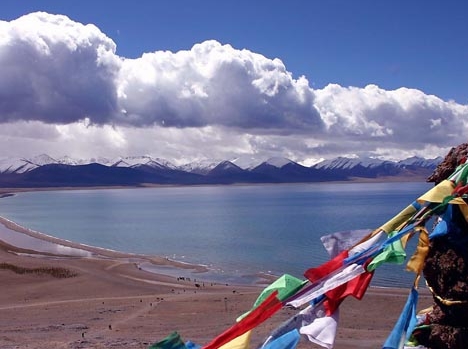
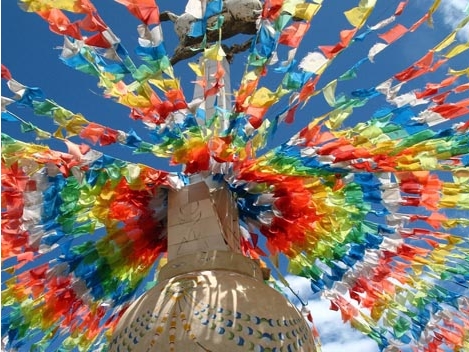 '
'
Making sacrificial offerings to QinghaiLake is a folk customs activity of rich religious features. It is also a cultural phenomenon, comprising multiple folk customs while expressing people's good wishes to exist harmoniously with nature.
In 2008, making sacrificial offerings toQinghaiLakewas listed into the second batch of the state-level intangible cultural heritage directory.
Making sacrificial offerings toQinghaiLakewas a tradition of the Mongolian ethnic group in the very beginning. The Mongolians, believing in Shamanism, accepted the doctrine of animism. They were convinced in particular that Heaven was the supreme god. In the Yuan Dynasty, the Mongolians cultivated the customs of extending sacrificial offerings to the Heaven, mountains and lakes. Since the Qing Dynasty, they expanded the scales of making sacrificial offerings toQinghaiLake, with more religious appearances. Meanwhile, Tibetans living round theQinghaiiLakealso joined in the ceremony.
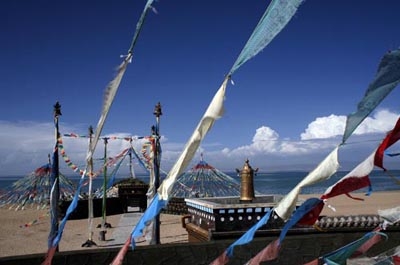
Large-scale sacrificial offerings to theQinghaiiLakecould be dated back to the reign of Emperor Yongzheng in the Qing Dynasty. In the second year under the reign of Emperor Yongzheng, Great General Nian Gengyao led troops to put down the rebellion of Danjin, a chieftain of the Mongolians in Qinghaii. When the troops chased the rebels to the bank of theQinghaiLake, they ran short of drinking water. At that moment, a group of horsemen galloped along the road. Some horse hooves happened to tread on the mouth of spring, which gushed out fresh water to solve the drinking water problem. The warriors, with martial spirits roused greatly, put on a spurt and wiped out the rebels. Hearing the news, Emperor Yongzheng made a decree extending the water god of theQinghaiiLakethe title ofLing Xian Xuan Wei, and a memorial tablet in theQinghaiiLakeGodTemple. The emperor decided to hold a ceremony giving sacrificial offerings to the God in August each year (July15 inthe traditional Chinese calendar). Since then, there has emerged large-scale ceremony making sacrificial offerings to theQinghaiiLake.
To date, the ceremony of extending sacrificial offerings to theQinghaiLakehas totally followed the Tibetan patterns. For the Tibetans, it is a sacred event to make sacrificial offerings to theQinghaiLake, something equivalent to making pilgrimages to theHolyMountainin a horse year and to theHolyLakein a goat year. Large-scale ceremony for extending sacrificial offerings to theQinghaiiLakewill be held one or two times each year. It will be a great luck if one could attend a ceremony chaired by the eight Living Buddhas around theQinghaiLake.
The first step in making sacrificial offerings to theQinghaiiLakeis to burn aromatic plants. Burn a mixture of tea, Qingke barley powder, butter and pine branches at a terrace around the lake to revere the God. During the period, all the people participating in the ceremony will circle around the terrace for three rounds in a clockwise order. For an instant, all the bugles are blown, and colorful paper of winged-horse patterns is scattered, praying for a bumper harvest and peace in the upcoming year.
Having burned the aromatic plants, Living Buddhas from all temples will chant sutras at the sacrificial altars, begging the Qinghai Lake God to bless all living creatures. After that, they will lead the people to cast five-color paper of winged-horse patterns to the sky, and pour food to stoves. When the sutras are chanted, it enters the climax of the ceremony – extending gifts to the Lake God.
At the end of the sacrificial offering ceremony, herders will hold a horse-racing activity.
QinghaiLake, known as theWestLakein the old days, and Cuo Wen Bo in the Tibetan language, means a green lake. It is called Ku Ku Nuo Er in the Mongolian language, meaning a blue sea.QinghaiLakewas surrounded with pasturelands of the Beihe ethnic group. It was therefore referred to as Beihe Qianghai. The Hans called it theCelestialSea. It was renamed as Qinghaii in the Northern Wei period(386-534).
Emperors of all dynasties saw theQinghaiLakeas a divine site. They would write inscriptions, raise monuments and confer titles to theQinghaiLake. It is known to all the people that when Princess Wencheng of the Tang Dynasty married Songtsen Gampo, the ruler ofTibet, they traveled past theRiyueMountain,DatangRiverandQinghaiiLake.
TheQinghaiLakehas cultivated numerous charming legendary stories. Xi Wang Mu, the goddess recorded inThe Mountain and Sea Bible, is said to live in the QinghaiLake.
Archaeological discoveries show that early in the Paleolithic period, theQinghaiiLakewitnessed human activities. This is testified with the unearthed stone-made scrapers, carvers and cutting devices. People would hunt in the area, showing that the Qinghaii area had warm climate, luxuriant forests and abundant grasses about 20,000 years ago.
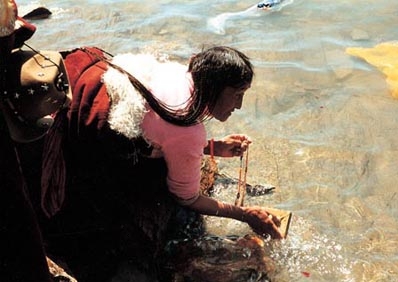
The most important of all gifts is a bag of five cereals, also termed as an auspicious vase. The bag contains such cereals as highland barley, wheat, peas, corns and broad beans. Besides, corals, beeswax and agates are grinded to powder and mixed with the five cereals. In the end, a sutra streamer is put along with them. A Living Buddha will pray and tie the bag. Afterwards, lamas and believers will bear the five-cereal bags and other offerings and, led by the Living Buddha, go to the lakeside in a formidable array.
When they have arrived at the lakeside, the Living Buddha will chant sutras and make ritual services. Lamas and believers will hold high the offerings to cluster around the Living Buddha. Hearing the order of the Living Buddha, they will cast the offerings to the lake, splashing billows amid a roar of cheers. It is said the five-cereal bags must be packed full before thrown into the lake. The fuller they are, the bags will sink faster, showing you are sincere. The lake god will be fond of you.
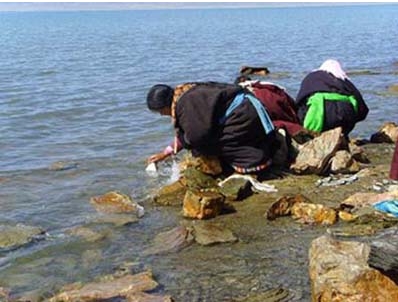
At the same time, many old people and women will knee at the lakeside, take off amulets and wash them in the lake. It is said that washing amulets in the lake that day will bless and protect the people for a year. Many lads will ride horse and run about in the lake wildly, also expecting blessing of the Lake God.
Another element of making sacrificial offerings to theQinghaiiLakeis to pay for rain. As local people say, it will rain in a few hours after the sacrificial offering ceremony each year.
When the ceremony is concluded, the lakeside will be covered with small pieces of red-and-green paper, printed with deer and horses (Lu Ma). Such pieces of paper are known as Lu Ma in the locality. Casting Lu Ma is a mode for people to express their feelings and desires to the God. In a legend, divine horses of deer horns will ascend to the heaven and dive into the lake, delivering messages to the God.